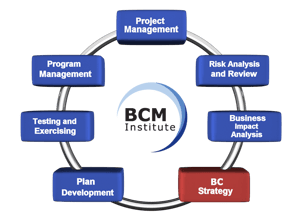What is BC Strategy?
The formulation of a business continuity (BC) strategy (BCS) marks the beginning of the business continuity plan or BC plan. This phase in the BCM planning methodology takes the outputs of the risk assessment and business impact analysis, analyses them, and synthesizes a strategy. As the new ISO 22301:2019 is published, "BC Strategy" is synonymous to "BC Strategies and Solutions" .
What is the equivalent of BC Strategy for CM and CC?
The equivalent of BC Strategy for our Crisis Management (CM) and Crisis Communication (CC) professionals implementing BC Strategy is referred to as "Crisis Strategy." For reader who are implementing CM or CC and aligned to the BCM planning methodology, read more about "What Crisis Strategy to be Adopted?"
 Why Implement BC Strategy?
Why Implement BC Strategy?
The BC strategy is deployed to mitigate risks that, despite existing controls, remain high; respond appropriately to identified incidents; and if necessary, recover from significant or prolong disruptions.
Unfortunately, some organisations choose to dispense with the BC strategy phase and move directly to writing a detailed  BC plan.
BC plan.
A common reason BCM planners give is that the BC strategy will become evident as the plan takes shape. For practical reasons, I prefer to first develop a BC strategy before jumping head on into BC plan development. It may take some time but it is worth the while.
Too many times have I seen weeks of effort going into writing a plan, only to have it shot down in a manner of minutes during a management meeting.
Better to first outline a BC strategy and get management’s feedback and approval to proceed, before investing long hours into writing the plan. Having an approved strategy also makes it easier to develop the plan, because of the presence of boundaries and possibly guidance by management on what direction to take.
Summary of BC Strategy
Ultimately, the outputs of the business continuity strategy phase would be used as follows:

1. Mitigation Strategy
Mitigation Strategy complements and supports the risk management program in the organisation by identifying and addressing areas of risk not adequately covered by existing controls.
2. Recovery Strategy
Recovery Strategy addresses the recovery of resources needed for the continuation of critical business functions within a prescribe RTO, failing which temporary operating procedures need to be employed.
3. Crisis (Incident) Response Strategy
Crisis Response Strategy determines the types of activities undertaken by the organisation in response to a disaster. Note that this component may be omitted if already addressed in a separate incident management or crisis management document.
If you want to read in-depth of the three strategies. Read What Are the Types of Business Continuity Strategy?
Conclusion
Typically the business continuity strategy outlines the structure of how to prevent, respond and recover from a disaster. It approaches recovery at a macro level and does not dwell on details. This is often useful in providing an overview to management and allows them to see the “big picture” for organisational recovery. It is important to gain their approval before we proceed to decompose the strategy into detailed actionable steps in the plan development phase of the project.
Learn More About Business Continuity Management (BC-CM-CC-ITDR)
You may want to know more about business continuity management courses.












